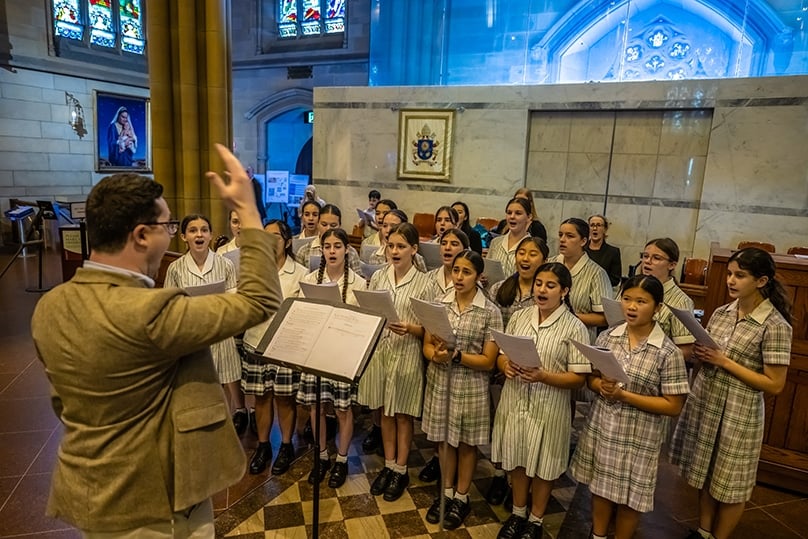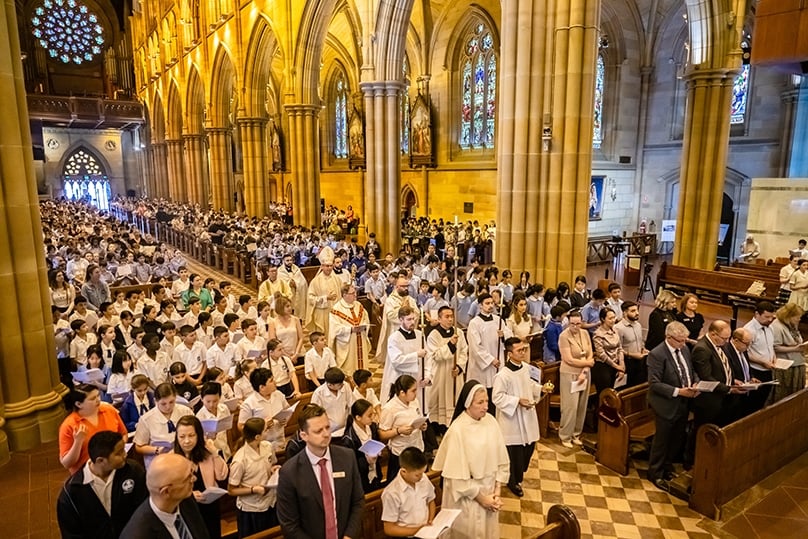
Ronan Reilly grew up singing the world’s most sublime music as a member of Australia’s longest-running musical ensemble, Sydney’s St Mary’s Cathedral choir.
There he gained a love of the church’s rich musical patrimony and deeper appreciation of his Catholic faith.
Now the 32-year-old director of the Jubilate Deo program is preparing to help ramp up its partnership with the Archdiocese of Sydney and pass on his passion for Gregorian chant and other liturgical music in schools, parishes, and for youth and clergy across the city.
“The program has been used in other dioceses but only in Sydney have we got a coordinated, concerted effort across the various areas, which is quite exciting,” he said.
In 1974 St Paul VI sent the world’s Roman Catholic bishops a selection of Gregorian chant in a booklet titled Jubilate Deo.
It included parts of the Mass such as the Kyrie and the Agnus Dei, and hymns including Salve Regina.
It was intended to be the minimum chant repertoire of the faithful, but is largely unknown—until now.
Reilly has taken up Paul VI’s vision for the Jubilate Deo program and uses the sainted pope’s resource as a basis for teaching a broad range of ancient and modern sacred music.
From the first workshop to a group of 60 senior students at Brigidine College, Randwick, in 2018 the program in schools is now bringing sacred music to students in 11 schools across the archdiocese and more are coming on board next year.
Reilly keeps lessons fun with icebreakers and games and has found that children will happily take Latin in their stride, as they’re used to learning about a variety of cultures and languages.
“The ultimate rationale behind the program from Pope Paul VI is that when we sing collectively—particularly monophonic music with its one-line, simple melody—whether with 10 people or 10,000, it’s a great musical analogy for the concept of unity,” he said.
“So for example during Mass in the cathedral this week when Bishop Umbers, in the person of Christ, sang ‘Peace be with you’ and 1,000-plus voices sang back in unison ‘And with your spirit’ it’s a literal sensation and experience, a tangible experience of the idea and the ideal of unity.

“Children tap into all these notions even on a subconscious level.
“And while as teachers we’re not privy to the inner workings of Our Lord in each student’s heart, obviously we know that this does work on the sacramental level and is a powerful means of transmitting grace and of course truth, goodness and beauty.”
Reilly points to the section on sacred music in the Vatican II Constitution on the Sacred Liturgy, Sacrosanctum Concilium, which says that Gregorian chant holds pride of place in the Roman rite.
“I think that’s a great starting point to appreciate or to re-contexualise our understanding of music and the liturgy—not because the document says it, but because the document is reflecting the reality that is received,” he said.
“The Gregorian melodies are not just artful, steady and beautiful on a natural level, they are deeply theological, and it’s in that context the church has jealously guarded that repertoire as her own and has said that then becomes the model.
“Does that mean there’s no place for other forms of music? Certainly not.”
But what about people who say they can’t sing?
“I would say that it’s a particularly Western or even Australian phenomenon to say I can’t sing,” he said.
“Unless there is a vocal cord or breathing inability or disability, everyone can vocalise a sound that we would call singing.
“Whether it contains what we highlight from one person to the next as sweetness or the quality of being dulcet, that’s a different question.
“But the church not only recommends but really strongly suggests and almost directs everyone at certain points of the year or certain feasts to join in the singing.
“That’s just how we praise God.”
